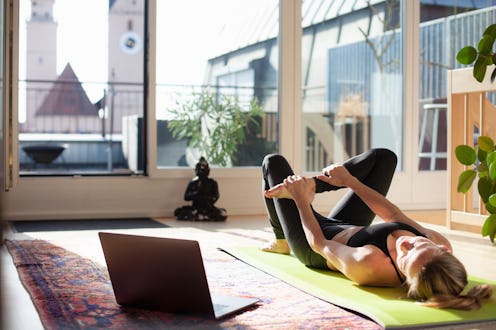Life
What Happens To Your Brain When You Live-Stream A Yoga Class

With social-distancing regulations closing gyms and other exercise spaces, lots of us are newly figuring out how to work out from home. Doing an Instagram livestream yoga class definitely isn't the same as going into the studio, but the resulting endorphins can help you deal with this new normal. Even if you miss the community of your spin class, working out at home can change your brain to cope better with isolation.
Finding movement that makes people happy and healthy at home is valuable right now, Dr. Natasha Trenacosta, M.D., a sports medicine specialist, tells Bustle. "The healthier we are, the better we will be at combatting viral and bacterial infections that may enter our body," she says. Beyond its immune system-boosting properties, though, exercise at home can help mood and regulate sleep, which are overwhelmingly good for brain health.
"Your body releases chemicals during exercise that can lift mood and improve symptoms of depression, which can unfortunately creep up in trying times," Trentacosta says. These include neurotransmitters like serotonin and dopamine, both of which are linked to better mood, and endorphins, which can suppress pain and improve brain function. Exercise's potential for stress relief and mood regulation is well-documented, which makes it particularly valuable during periods when the world outside is scary.
If you're having trouble keeping a regular day-night routine, or are struggling to sleep due to coronavirus anxiety, regular exercise can help you fall asleep and stay asleep. "Exercise is helpful in supporting quality sleep, a critical component of general good health and well-being," Dr. Scott Kaiser M.D., a family medicine physician, tells Bustle. Exercise has been shown to play a role in regulating the body's circadian rhythms, helping the brain adopt a regular sleeping pattern — which, in turn, leads to better brain functioning.
One drawback of exercising at home is its solitary nature. Small studies have found that people experience better outcomes for physical and mental health when they exercise together in groups. Scientists think this is partly because of the mutual support of communal exercising, and also because some healthy competition might make people push a bit harder. Laughing with others also increases endorphins, so falling off a machine and giggling about it can boost the endorphins you get from an exercise class.
That's an incentive to get roommates or family members involved in a yoga routine together, provided nobody is symptomatic. People doing communal exercise at home must take precautions, though; Dr. Trentacosta says anybody who shares exercise equipment, like a stationary bike or dumbbells, must clean them thoroughly before they pass from one person to another. Before going on a run outside, too, consider your risk. "There is evidence that the virus can live in the air for up to 3 hours," Dr. Julia Blank M.D., a family medicine physician, tells Bustle. She recommends that people shouldn't do any outdoor exercise if they can't maintain at least six feet of distance from others.
While it may be harder to stay motivated when there aren't 40 other people in the room, an at-home exercise routine still hugely valuable. "Beef up that home exercise routine, and while you're at it, call those you know who might have less access and lend a hand to help them get moving as well,” Dr. Kaiser says.
If you think you’re showing symptoms of coronavirus, which include fever, shortness of breath, and cough, call your doctor before going to get tested. If you’re anxious about the virus’s spread in your community, visit the CDC or NHS 111 in the UK for up-to-date information and resources, or seek out mental health support. You can find all Bustle’s coverage of coronavirus here, and UK-specific updates on coronavirus here.
Experts:
Dr. Julia Blank M.D., family medicine physician
Dr. Scott Kaiser M.D., family medicine physician
Dr. Natasha Trenacosta M.D., sports medicine specialist
Studies cited:
Dolezal, B. A., Neufeld, E. V., Boland, D. M., Martin, J. L., & Cooper, C. B. (2017). Interrelationship between Sleep and Exercise: A Systematic Review. Advances in preventive medicine, 2017, 1364387. https://doi.org/10.1155/2017/1364387
Manninen, S., Tuominen, L., Dunbar, R.I., et al. (2017) Social Laughter Triggers Endogenous Opioid Release in Humans. J Neurosci. 37(25), 6125-6131. doi: 10.1523/JNEUROSCI.0688-16.2017.
Heijnen, S., Hommel, B., Kibele, A., & Colzato, L. S. (2016). Neuromodulation of Aerobic Exercise-A Review. Frontiers in psychology, 6, 1890. https://doi.org/10.3389/fpsyg.2015.01890
Kanamori, S., Takamiya, T., Inoue, S., Kai, Y., Kawachi, I., & Kondo, K. (2016). Exercising alone versus with others and associations with subjective health status in older Japanese: The JAGES Cohort Study. Scientific reports, 6, 39151. https://doi.org/10.1038/srep39151
Lin, T. W., & Kuo, Y. M. (2013). Exercise benefits brain function: the monoamine connection. Brain sciences, 3(1), 39–53. https://doi.org/10.3390/brainsci3010039
Yorks, D.M., Frothingham, C.A., Schuenke, M.D. (2017) Effects of Group Fitness Classes on Stress and Quality of Life of Medical Students. The Journal of the American Osteopathic Association, 117 (11), e17 .DOI: 10.7556/jaoa.2017.140